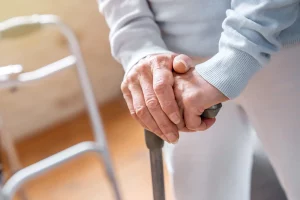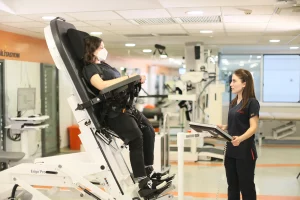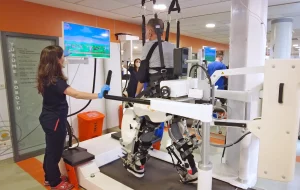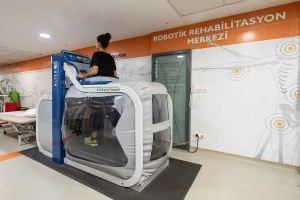Stroke is injury of the brain tissue due to brain hemorrhage or brain embolism. In patients who had a stroke:
- Loss of movement in the leg and arm in one side of the body
- Sensory impairment in one side of the body
- Visual disorders
- Loss in cognitive functions
- Loss of balance and coordination disorder are observed.
The patients who developed paralysis after stroke lose ability to walk partially or entirely because of the problems mentioned above. Therefore, the patients and their relatives wonder if it is possible to walk again. Amount of recovery depends on the location and severity of the stroke, age of the patient and the applied treatment.
Is It Possible to Walk Again After Paralysis?
It is possible to walk again for many of the stroke patients, but this requires intensive work. The patients with a potential to walk again after stroke may remain unable to walk or with walking impairments if they cannot not reach the suitable treatment.
In the patients with paralysis caused by stroke, exercises which train muscles and brain are done with physical therapy and rehabilitation applications. When these exercises are done with a suitable intensity, the lost functions are started to be gained thanks to the ability of the brain to reorganize itself (neuroplasticity). To retrain the brain the varied movements are done with many repetition, and neuro-rehabilitation methods and robotic rehabilitation devices are used.

For walking training, the physical therapy and rehabilitation should be started at the earliest period. After the patient survived the life-threatening situation and stabilized medically, the intensive rehabilitation work starts in intensive care and then, at the inpatient physical therapy center. Problems like bed sores, muscle shortness and joint stiffness may be seen in the patients who are late to reach the therapy. These problems render the relearning of walking difficult.
When does a Paralyzed Patient Walk?
Severity of the stroke is among the factors which determine the time of walking for the paralyzed patient.
- In case of mild strokes, most of the patients regain the ability to walk again in the first 6 months.
- This duration may take 1 year in moderate, 2 years in severe cases of stroke.
- In the situations of very severe stroke, the patient may not regain the ability to walk.
Healing capacity of brain after stroke is at its maximum in the first 6 months. Recovery speed may decrease after a year. But this does not mean that recovery is impossible after 2 years. Even if the patient could not get suitable treatment in time, they should work with patience without giving up. It should not be forgotten that the recovery process only ceases if the patient gives up.
Walking ability cannot be gained spontaneously. The patient is made correct exercises with suitable frequency with physical therapy and rehabilitation applications and robotic physical therapy devices and brain’s relearning of the movement is stimulated.
What are Done to Walk Again After Paralysis?
From the early period, in-bed exercises are done to prevent muscle shortness and joint stiffness. Stimulations for the recovery of brain are given during these exercises. As the movement reappear, more active exercises are proceeded.

When the patient is in a suitable condition, sitting exercises and body control trainings start. Trainings of standing afoot with the help of 1-2 persons, passing the load onto the feet and taking the first steps are done in the phase of standing up.
At the early phase of walking, the auxiliary devices put on the ankle (AFO) can be used. These devices support the muscles which still could not gain their function and enables the patient to walk properly. Sometimes these devices may be used for a long time or permanently.
As walking develops, type and severity of the exercises also change. Activities like walking laterally, walking backwards, climbing up to and down from stairs may be added.
As the patient who in the beginning walked by the help of 1 or 2 persons shows development, they are regain walking with less help with an auxiliary device like a canadian or walking stick and finally, independently.
Robotic physical therapy devices are used from the early period to regain walking in the paralyzed patients.
Treatment of Paralysis with Walking Robots
Robotic physical therapy devices enable the stroke patients to be trained in a safe environment, regular pattern and intense way. Thanks to this, the brain is stimulated for recovery. The assistive robotic physical therapy devices for walk are:

Erigo Pro-Robotic Bed
Erigo Pro-Robotic Bed enables the patient to be brought to the upright position in control when they cannot stand afoot or even sit down at the early period of disease. Bringing the patient to the upright position causes prevention of diseases which develop due to lying down for a long time. The patient who stands upright learns head and body control and therefore is prepared for the phase of standing afoot.
The robotic legs in the device make the patient do movements like walking. Thus, the patient prepares for walking and transition to other robotic devices.

Lokomat Pro-Gait Robot
With Lokomat Pro- Gait Robot, it is possible to make the patient do walking exercises even in the severe brain injury cases. While the robotic external skeleton and robotic legs make the patient do walking exercise; the patient watches their walk on the screen and plays the games which they control with their leg movements.
If the patient does not have sufficient muscle strength and cannot walk alone, the robotic system makes the patient walk passively. As the patient’s muscles gain strength, the support given by the robotic system decreases. This time, suitable resistances are given, and walking is developed.
The patient who cannot walk normally performs the proper walking with the gait robot, and thanks to this, relearning of walking is stimulated in brain. Besides, motivation and participation of the patient who plays games while doing walking exercise increases.

Alter G Anti-Gravity Treadmill
In case of the patients who started walking but cannot walk balanced and for long, Alter G Anti-Gravity Treadmill is proceeded. Alter G can decrease body weight of the patient up to 80% with respect to gravity. Thanks to this, the patient can walk in a safe environment with less exhaustion. Muscle strength and exercise capacity are enhanced.
Reference: flintrehab.com

